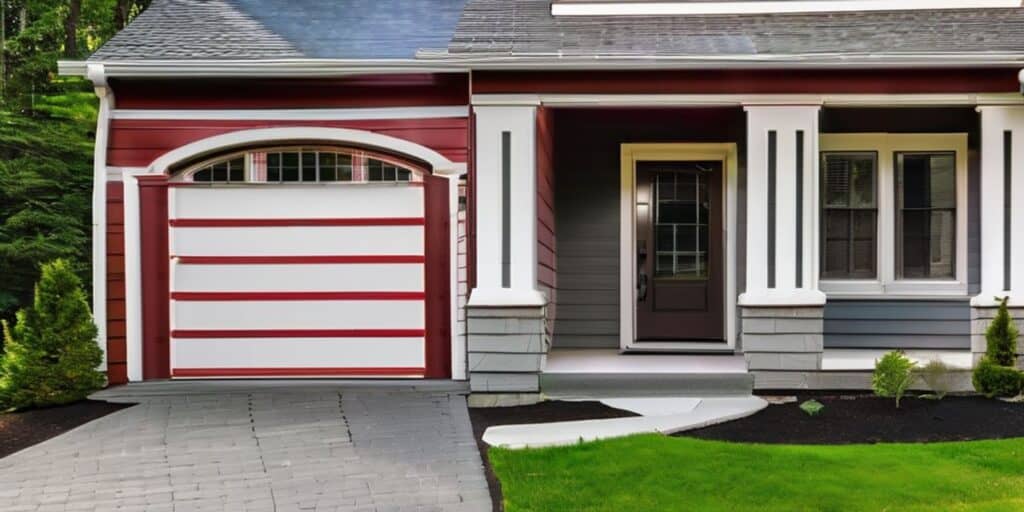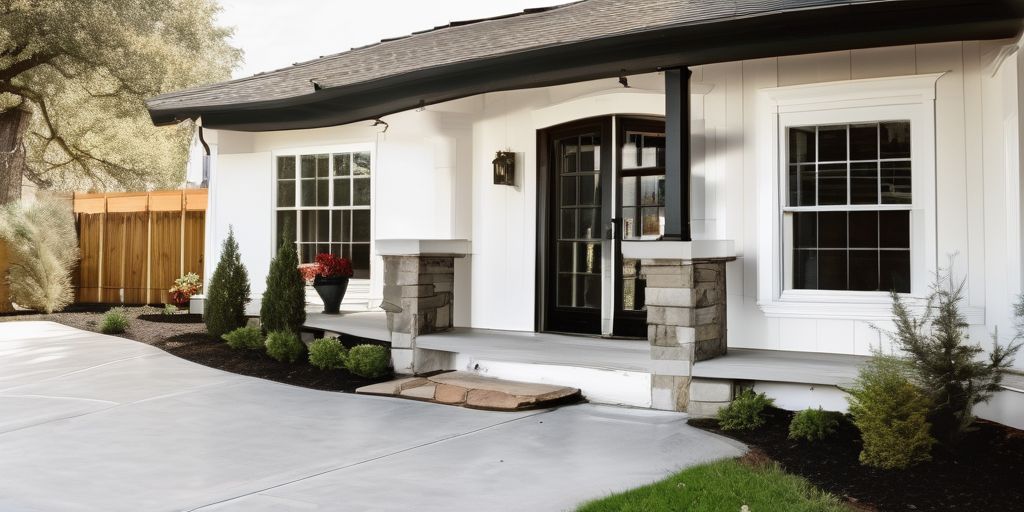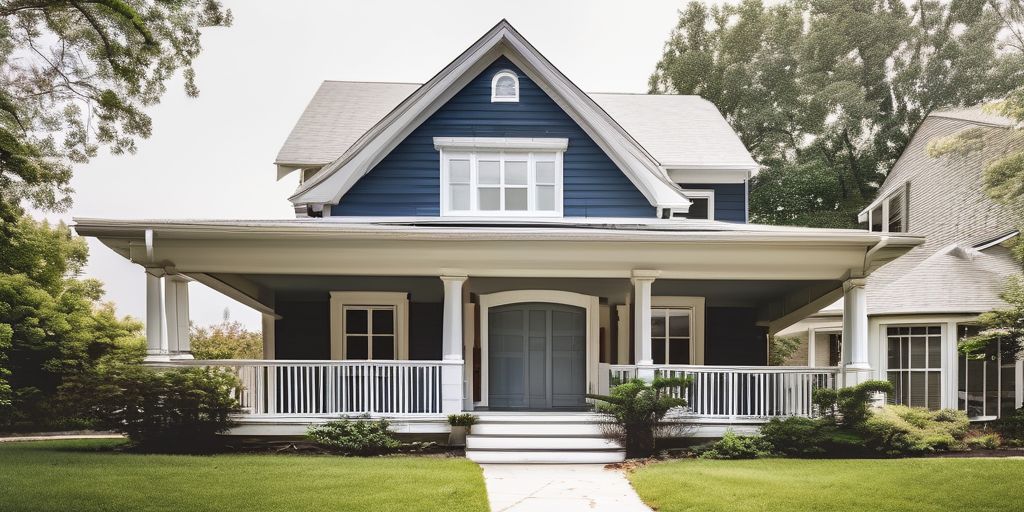Painting aluminum siding in the fluctuating temperatures of Oakville presents unique challenges. This article delves into the various aspects of painting in such conditions, from understanding the impact of weather on paint application to the maintenance of the newly painted surface. With the right preparation, tools, and techniques, homeowners can achieve a professional-looking finish that withstands the test of time and weather.
Key Takeaways
- Proper timing is crucial; avoid painting during extreme weather or the heat of the day to prevent rapid drying and patchy finishes.
- Surface preparation, including scraping and cleaning, is essential for a smooth and durable paint job on aluminum siding.
- Selecting the right paint and additives can enhance the weather resistance and longevity of the paint on outdoor surfaces.
- Applying paint evenly and timing the coats correctly during temperature fluctuations can achieve a professional and lasting finish.
- Regular maintenance, such as cleaning and inspecting the siding, helps preserve the aesthetic appeal and functionality of the painted surface.
Understanding Aluminum Siding and Weather Dynamics
The Impact of Temperature Shifts on Paint Application
When painting aluminum siding, understanding and adapting to temperature shifts is crucial for a durable finish. Temperature fluctuations can significantly affect the drying time and final appearance of paint. Here are some key considerations:
- Temperature: Aim for a moderate range, typically between 50-85 degrees Fahrenheit, to ensure optimal paint application and drying.
- Time of Day: Paint during the morning or late afternoon to avoid the peak heat hours that can cause the paint to dry too quickly.
- Adaptation: Be prepared to adjust your painting schedule based on the day’s forecast and sudden weather changes.
Remember, the goal is to avoid painting in extreme conditions, which can lead to poor adhesion and premature aging of the paint job.
By choosing the right type of paint, monitoring the weather, and preparing the surface properly, you can adapt to temperature changes and achieve a resilient and attractive finish on your aluminum siding.
Choosing the Right Time of Day for Painting
Selecting the optimal time of day for painting aluminum siding is crucial for achieving a smooth and even finish. Avoid painting during the peak heat hours when the sun’s intensity can cause the paint to dry too quickly, leading to a patchy appearance. Instead, aim for the cooler parts of the day, such as early morning or late afternoon, to ensure the paint has adequate time to settle before drying.
- Check the weather forecast to choose days with mild temperatures and low humidity.
- Begin painting on the shaded side of the house to avoid direct sunlight.
- Monitor temperature changes throughout the day to adjust your painting schedule accordingly.
When planning your painting project, consider the typical weather patterns in Oakville. For instance, painting during a less humid season can result in a better finish.
By carefully choosing the right time of day and being mindful of the weather conditions, you can enhance the longevity and appearance of your painted aluminum siding. Remember to consult experts if you’re unsure about the best time to start your project.
Protecting Your Paint Job from Weather Extremes
When it comes to painting aluminum siding, the unpredictable weather in Oakville can pose a challenge. Weather conditions and paint quality are crucial for the longevity of aluminum siding. To ensure that your paint job stands the test of time, consider the following protective measures:
- Preventative Maintenance: Regularly clean the siding with a mild soap or detergent to avoid accumulation of dirt and grime that can wear down the paint.
- Inspection and Repairs: Conduct consistent inspections and address any damage promptly to maintain the siding’s integrity.
- Weather-Resistant Products: Use paints and primers specifically designed to withstand temperature fluctuations and harsh weather.
By taking these steps, you not only protect the siding but also maintain its aesthetic appeal, potentially increasing your property’s value.
Remember, proper preparation is as important as the painting process itself. Cleaning, repairing, and sanding the siding, along with using a suitable primer, are essential for a durable finish. With the right approach, your aluminum siding can remain vibrant and protected, even when Oakville’s weather is at its most extreme.
Preparation is Key: Getting Your Siding Ready
Scraping and Sanding: The First Steps to a Smooth Finish
Before applying a fresh coat of paint to aluminum siding, it’s crucial to start with a clean, smooth surface. Proper preparation, sanding, and cleaning are essential for a successful aluminum siding paint job. Attention to detail and choosing the right tools can improve longevity and appearance. Here are the initial steps to ensure your siding is ready for painting:
- Scrape any old, flaking, or chipping paint using a wide blade paint scraper.
- Sand the surface with coarse sandpaper to smooth out any rough spots.
- After scraping, use a finer grit sandpaper, like 220 grit, to achieve an even and smooth finish.
- Ensure that the entire surface is uniform and ready for the next steps in the painting process.
Surface preparation includes scraping, filling, repairing, masking, and priming before spray painting aluminum siding for a professional finish. It’s important to not rush this stage, as the quality of your paint job heavily depends on the meticulousness of your prep work.
Remember, a well-prepared surface will not only look better but will also hold the paint longer, reducing the need for frequent touch-ups.
Cleaning the Surface: Ensuring a Dirt-Free Area for Painting
Before the application of paint, it’s crucial to ensure that the aluminum siding is free from any dirt, debris, or residues. A clean surface is essential for the paint to adhere properly and for achieving a smooth, professional finish. Follow these steps to prepare your siding:
- Use a stiff bristle brush or broom to remove all loose debris and dirt.
- Pay special attention to crevices and corners where dirt tends to accumulate.
- After brushing, use a garden hose or pressure washer to rinse the surface thoroughly.
- Allow the siding to dry completely before proceeding to the next step.
Remember, meticulous cleaning is not just about aesthetics; it’s about creating a foundation for the paint to last. Skipping this step can lead to peeling and flaking, compromising the durability of your paint job.
In Oakville, where the weather can be unpredictable, it’s especially important to choose a dry day for cleaning to ensure the siding dries properly. If you’re near the Bronte Creek Provincial Park, consider the additional debris from nearby trees and plan accordingly.
Priming Aluminum Siding: The Foundation for Durability
Priming your aluminum siding is a crucial step in ensuring a durable finish that can withstand the elements. Here’s why primer is essential:
- It provides a uniform surface for paint application.
- Primer ensures better adhesion of paint to the aluminum surface.
- It acts as a protective layer, helping to prevent corrosion.
When selecting a primer, it’s important to choose one that is specifically designed for use on aluminum siding. This will ensure the best possible bond between the siding and the paint. Follow these steps for effective priming:
- Clean the siding thoroughly to remove any dirt, grease, or debris.
- Sand the surface lightly to create a texture that the primer can grip.
- Apply the primer evenly across the siding, ensuring complete coverage.
Remember, a well-applied primer can significantly extend the life of your paint job, especially in areas with temperature shifts like Oakville.
After priming, allow sufficient time for the primer to dry before proceeding with painting. This step is vital for achieving a smooth and even finish on your aluminum siding.
Selecting the Right Paint and Tools for the Job
Choosing Paints Suited for Aluminum and Outdoor Conditions
Selecting the appropriate paint for aluminum siding is crucial, especially when considering the fluctuating temperatures in Oakville. The right paint will ensure that your exterior painter’s efforts withstand the test of time and weather.
- Acrylic latex paints are often recommended for aluminum siding due to their durability and flexibility.
- Oil-based paints can be used but may require more maintenance over time.
- Paints with UV protection are beneficial to prevent fading from the sun’s harsh rays.
- Mildew-resistant paints help in maintaining the appearance and integrity of the siding.
Exterior painter professionals understand that the quality of the paint is as important as the application process. When painting in areas with temperature shifts, like Oakville, it’s essential to choose paints that are specifically formulated for outdoor use and can handle the expansion and contraction of the aluminum siding.
While the selection of paint is a key factor, it’s also important to consider the finish. Glossy finishes tend to highlight imperfections, while matte or satin finishes can provide a more forgiving appearance on the aluminum surface.
Remember, the goal is to achieve a long-lasting, aesthetically pleasing result that protects your home from the elements. With the right paint, your aluminum siding can look fresh and vibrant for years to come.
Essential Tools for a Flawless Application
When undertaking the task of painting aluminum siding, having the right tools at your disposal is crucial for achieving a professional finish. Proper preparation is key for lasting results, and this includes selecting the appropriate equipment for the job at hand.
- Paint Rollers and Brushes: For large, flat areas, rollers can provide quick and even coverage, while brushes are perfect for cutting in around edges and in tighter spaces.
- Paint Sprayer: For an even and efficient application, a paint sprayer is ideal, especially for larger projects. It can also help in reaching those hard-to-paint areas with ease.
- Drop Cloths: Protecting the surrounding area from paint splatters is essential. Drop cloths can be used to cover landscaping and nearby features.
- Ladder or Scaffolding: Safety is paramount, and the right elevation equipment will ensure you can reach all areas of the siding comfortably and safely.
Remember to consider temperature, humidity, and precipitation when painting exterior surfaces. These factors can significantly affect the drying time and the overall finish of the paint job.
Combining roller and spray techniques can achieve optimal results, especially when dealing with the varied weather conditions in Oakville. It’s also beneficial to choose eco-friendly coatings for urban appeal and environmental health.
Innovative Additives for Enhanced Protection
When painting aluminum siding, the addition of innovative additives can significantly improve the durability and protection of the finish. These additives are mixed directly into the paint, providing a seamless integration of protective features.
- Outdoor additives act as a powerful stain blocker, ideal for preventing tannins from bleeding through the paint, especially on soft or sappy woods.
- Borax-based additives serve as an excellent antibacterial agent and mold inhibitor, crucial for sidings exposed to moisture.
Choosing the right additives for your paint can make a substantial difference in the longevity and appearance of your aluminum siding. It’s important to select additives that are compatible with the paint you’re using and the specific challenges of the Oakville climate.
Advanced coatings for aluminum siding in Oakville provide enhanced durability, weather resistance, and easy maintenance. Professional application recommended for longevity and curb appeal.
Remember, while additives can offer enhanced protection, they should not replace proper surface preparation and the use of high-quality paint. For a unique touch that resonates with the local aesthetic, consider drawing inspiration from the natural beauty of Oakville’s landscapes or landmarks like the Bronte Creek Provincial Park.
The Painting Process: Techniques for a Professional Look
Applying Paint Evenly During Temperature Fluctuations
When painting aluminum siding, it’s crucial to adapt to temperature changes to ensure an even application. Monitor the weather closely and aim to paint when temperatures are stable. Here are some tips to help you achieve a smooth finish:
- Start early in the morning or later in the afternoon to avoid the heat of the day.
- Apply paint in thin, even layers to prevent it from drying too quickly and resulting in a patchy finish.
- Use a thermometer to keep track of the siding temperature, not just the air temperature.
Temperature fluctuations can cause paint to behave unpredictably. For instance, dark paint can enhance the appeal of your home but may absorb more heat, while light paint reflects sunlight and can be more forgiving during application. Always avoid painting in extreme conditions, as this can compromise the quality of your paint job.
Remember, preparation is just as important as the painting itself. Ensure your siding is clean, dry, and primed before you begin applying paint.
By following these guidelines, you can maintain a consistent quality throughout the painting process, even when dealing with Oakville’s variable climate.
Layering and Drying: Timing Your Coats
When painting aluminum siding, the timing of applying and drying multiple coats is critical. Proper layering ensures a uniform appearance and aids in the overall durability of the paint job. Here are some key considerations for timing your coats:
- Temperature and Humidity: Paint dries best at moderate temperatures and low humidity. In Oakville, aim for a day with stable weather conditions to avoid rapid temperature shifts that can affect drying times.
- Time of Day: The ideal time to apply paint is during the late morning and afternoon hours. This allows the paint to dry evenly as the daylight helps in the dehydration process.
- Interval Between Coats: Allow the first coat to dry completely before applying the second. This usually takes a few hours, but always refer to the paint manufacturer’s recommendations.
Remember, patience is key. Rushing the drying process can lead to an uneven finish and may compromise the paint’s ability to protect your siding.
In addition to these points, consider the following table for a general guideline on drying times under different conditions:
Finishing Touches: Inspecting and Retouching
After applying the final coat of paint to your aluminum siding, it’s crucial to take a step back and inspect the work. Look for any inconsistencies or missed spots that may need a touch-up. This is where attention to detail pays off, ensuring a stunning finish that stands up to the Oakville climate.
Remember, the goal is to achieve a uniform appearance that not only looks professional but also provides a protective layer against the elements.
Here are some steps to follow during the inspection phase:
- Examine the siding from different angles to catch any drips or streaks.
- Check for any areas that may require additional paint to achieve full coverage.
- Use a small brush for retouching to maintain precision and avoid over-painting.
If you encounter any significant issues during your inspection, it may be necessary to apply another coat. However, this should be done with caution to avoid creating a thick layer that could crack or peel over time.
Maintaining Your Newly Painted Siding
Regular Cleaning and Care for Long-Lasting Results
Maintaining the appearance and durability of your aluminum siding involves a commitment to regular cleaning and care. Proper application techniques and maintenance for aluminum siding with environmentally friendly paint ensure durability, aesthetics, and sustainability. Regular cleaning and inspection are key for long-lasting results.
To keep your siding in top condition, consider the following routine:
- Weekly: Gently rinse the siding with water to remove surface dirt and debris.
- Monthly: Inspect the siding for any signs of damage or areas that may need touch-ups.
- Seasonally: Perform a more thorough cleaning with a mild detergent solution to tackle any accumulated grime.
Remember, the goal is to maintain the siding’s integrity and appearance without causing damage. Therefore, always use soft cloths or brushes and avoid abrasive cleaners.
Regular maintenance of aluminum siding is crucial for durability and appearance. Inspections, cleaning, and quality paint are key. Consider climate and surroundings for longevity and aesthetic appeal. While Oakville’s Bronte Creek Provincial Park offers a picturesque backdrop, it’s important to account for the potential impact of nearby trees and natural elements on your siding.
When to Reapply: Signs Your Siding Needs a New Coat
Aluminum siding is a durable and low-maintenance option for homes, but even the sturdiest materials require attention over time. Knowing when to reapply paint to your aluminum siding is crucial for maintaining its appearance and integrity. Here are some signs that it might be time for a new coat of paint:
- Fading or discoloration, which can be gradual and subtle
- Chalking, where the paint surface turns powdery
- Peeling or flaking paint, often due to weather exposure or previous poor application
- Dents or damage that have been repaired and need to be seamlessly blended with the rest of the siding
Regular maintenance is essential to extend the life of your paint job. This includes cleaning, inspecting, and touching up areas as needed. It’s also important to consider the local climate when planning maintenance, as areas with harsh weather may require more frequent attention.
Choosing high-quality paint is not only about aesthetic appeal; it’s about durability. A quality paint job can last anywhere from 5 to 10 years, depending on the paint used and the local weather conditions.
If you’re unsure whether it’s time for a repaint, look for these indicators and assess the overall condition of your siding. When in doubt, consulting with a professional can provide peace of mind and ensure that your home continues to look its best.
Professional Services: When to Call in the Experts
While a DIY approach to painting aluminum siding can be rewarding, there are times when the expertise of a professional is invaluable. Knowing when to seek professional help can save you time and ensure a high-quality finish. Here are some scenarios where expert assistance is recommended:
- Complex architectural features that require specialized techniques
- Large-scale projects where efficiency and uniformity are critical
- Situations where safety is a concern, such as working at heights
Professional services offer more than just skilled labor; they bring a wealth of knowledge about local weather patterns and the best materials for the job. In Oakville, where temperature shifts can be abrupt, this local expertise is particularly beneficial. For instance, understanding how to protect your paint job from the brisk winds near Lake Ontario can make a significant difference in the longevity of your siding.
It’s essential to recognize when a project exceeds your skill level or available time. In such cases, hiring a professional can provide peace of mind and a guarantee of quality workmanship.
Remember, professionals have access to high-grade equipment and materials that might not be readily available to the average homeowner. They also stay updated on the latest industry standards and regulations, ensuring that your home’s exterior meets all necessary criteria for durability and safety.
Keep your home’s exterior in pristine condition with our expert siding painting services. Regular maintenance ensures your siding remains vibrant and protected year-round. Don’t let the elements take their toll on your investment. Visit our website to explore our maintenance tips and schedule a consultation to keep your siding looking like new. Act now and ensure your home continues to make a striking impression!
Wrapping Up: Painting Aluminum Siding in Oakville’s Varied Climates
In conclusion, painting aluminum siding in Oakville requires careful consideration of temperature shifts to ensure a flawless finish. As we’ve explored, the key to a successful paint job lies in preparation, choosing the right products, and timing the project to align with favorable weather conditions. Remember to avoid painting during extreme heat to prevent rapid drying and patchy results. Utilize outdoor additives for natural paint mediums to protect your hard work from the elements. Regular maintenance, including cleaning and lubricating hinges, will keep your painted surfaces looking fresh and functional. Whether you’re tackling a garden fence or an entire home exterior, Oakville’s climate challenges can be managed for an exceptional outcome. For expert advice and quality supplies, consider reaching out to trusted brands like Promain for the best results.
Frequently Asked Questions
What is the best time of day to paint aluminum siding to avoid temperature-related issues?
The best time to paint aluminum siding is during the cooler parts of the day, such as early morning or late afternoon, to avoid the strong heat of midday which can cause the paint to dry too quickly and result in a patchy finish.
How do I prepare aluminum siding for painting?
Prepare aluminum siding by scraping off any flaking or chipped paint with a wide blade paint scraper, sanding the surface to create a smooth finish, washing it to remove dirt, and applying a primer designed for aluminum to ensure paint adhesion and durability.
Can I paint my aluminum siding during fluctuating temperatures?
Yes, but it’s important to monitor the weather forecast and choose a period with consistent, dry conditions. Temperature fluctuations can affect paint drying times and finishes, so painting in stable weather is preferable.
What type of paint should I use for aluminum siding?
Use paints specifically formulated for aluminum and exterior conditions, which often include additives for extra protection against weathering. Acrylic latex paints are commonly recommended for aluminum siding.
Is there a way to protect my painted aluminum siding from harsh weather?
Yes, use outdoor additives mixed directly into your paint to enhance protection against weather damage. Regular cleaning, lubrication of moving parts, and seal replacement can also help maintain the siding’s weather-resistance.
How often should I repaint aluminum siding?
Repaint aluminum siding when you notice signs of wear such as fading, chipping, or cracking. Maintaining the paint with regular cleaning and touch-ups can extend the time between full repaints.










